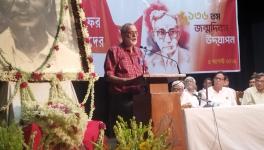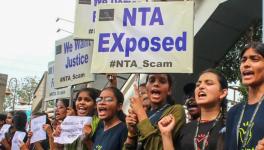Communalism and Working Class Struggles

Workers in India, Image Courtesy: commons.wikimedia.org
Comrade BT Ranadive used to reminisce that in pre-independence Bombay (as it was then called) there would occasionally be impressive workers’ strikes at the call of Communist-led trade unions which were powerful in the city at that time, at which Hindu and Muslim workers would stand shoulder to shoulder. Not surprisingly however, given the colonial context, these strikes were not always successful, and, when that happened, they would often be followed by communal riots.
This cycle, of unity followed by horrendous disunity leading even to communal riots, was an expression of contending forms of consciousness among the workers: a budding class consciousness that brought them together by overcoming their communal and other differences and pointed in a direction that led to the liberation of all; and a communal consciousness, being assiduously promoted by reactionary vested interests, that was a false consciousness, in the sense that it pointed in a direction that led to the liberation of none, but, on the contrary, tied all of them even more firmly to the yoke of their unfreedom.
This cycle however also underscored another important point, namely that people do not simply live as individuals, that some form of a community life, with a supra-individual consciousness informing it, constitutes an existential necessity for them. This is a point that liberal thought systematically ignores. But once it is recognised, then it follows that if divisive and potentially dangerous forms of consciousness that make it possible for reactionary vested interests to generate internecine conflicts among the people, are to be overcome, then the way to do so is not by promoting a cult of the pure individual, but by locating the individual in an alternative supra-individual consciousness.
This can only be class consciousness because class consciousness consists not in pitting one group of people against another but in developing a knowledge of the tendencies immanent in structures, ie, in pitting the people as a whole against these structures. And class consciousness can arise only through common struggles over the conditions of material life, transcending religious, ethnic, caste and other differences. Put differently, collective forms of struggle involving the working people irrespective of communal and other differences, over their conditions of life, is an essential social pre-requisite for secularism and, of course, for democracy, whence it follows that trade unions which represent the primary organisations initiating such struggles, are an essential pre-requisite for the sustenance of a secular and democratic polity.
This is so obvious a proposition that what comes as a surprise is the denial of it by the entire ideology of capitalism that professes to uphold democracy. Right from the beginning capitalism has opposed the formation of trade unions, or “combinations” as Marx had called them, and has apotheosized the individual. The original liberal thinkers like Adam Smith did not mince words in denouncing this hypocrisy of the capitalist system, since employers everywhere did not act only individually but were in tacit collusion, even as workers’ combinations were being denounced by them. But later liberal writers, taking their cue from what Marx had called “vulgar economy”, promoted this apotheosis of the individual, not just as a supposed fact characterising the system, but as its supreme virtue. “Combinations” among workers were to be discouraged and broken up, as being socially harmful. And this view has been carried forward as the ultimate truth, under the neoliberal economic regime, when a host of liberal writers have demanded “labour market flexibility” as a socially desirable policy. Such “labour market flexibility”, since it entails the complete freedom of capitalists to “hire and fire”, constitutes an assault on trade union activity (as anyone forming or joining a trade union will be sacked immediately).
The latter-day liberal world-view therefore is afflicted with a deep contradiction. On the one hand it professes, and quite genuinely, let us accept for the moment, a disdain for communalism and other forms of supremacism, majoritarianism and fundamentalism. On the other hand by opposing trade unionism, by making it impossible for people to combine in the secular space for resisting their class oppression, it prepares the ground, for reasons discussed earlier, precisely for the ascendancy of supremacism, majoritarianism and fundamentalism, the very tendencies it professes to disdain.
The liberal view in contemporary capitalism, in particular, visualises, and advocates, at least in societies like ours, a fragmentation of the working people into an ocean of individuals who do not, need not, and should not combine for their economic betterment. It suggests that the outcome of their not combining, via boosting capitalists’ state of confidence, would be a high rate of investment, and hence of economic growth, whose benefit would “trickle down” to them either directly, or through the intermediation of the State (which gets more tax revenue with higher growth and hence spends more for improving their welfare).
This view is erroneous for two reasons. One of these is much discussed, while the other is scarcely recognised. The much discussed reason is that it is simply factually wrong: capitalists’ investment, which responds largely to the growth in the size of the market, does not increase just because the work-force is made more docile; on the contrary, by keeping down wages, such docility actually constricts the size of the market and hence the level of investment and growth, a point that was underscored by none other than a yesteryear liberal, John Maynard Keynes. Besides, whatever growth does occur in such a regime, characterised by the fragmentation and hence docility of the working people, does not “trickle down” to them, owing precisely to this very docility on their part. It does not trickle down “spontaneously” because the existence of large unemployment and underemployment which this growth does little to eliminate, intensifies competition among them and keeps their earnings chained to a bare subsistence level. And it does not trickle down through the intermediation of the State, because the State, in the name of boosting investors’ confidence and hence keeping this growth process going, makes larger and larger transfers to the capitalists, which means that despite growth, and hence growing fiscal resources, public expenditure for enhancing the welfare of the working people continues to languish or even diminish.
It is, however, the less discussed reason why this liberal view is wrong which is of importance here. And this consists in the fact that in the absence of mobilisation of the working people along class lines, what occurs is not their pure individualisation, as liberalism supposes, but the formation of other supra-individual groupings, of which the communalisation promoted by reactionary vested interests is a classic example. In other words the fragmentation of the working people in the realm of the economy goes hand in hand, in the Indian context, with the growth of majoritarian Hindu communalism and supremacism, which in turn threatens a backlash of minority communalism.
The fact that there has been such a fragmentation of the working people under the neoliberal regime is undeniable. True, there have been occasional courageous shows of strength like the several short-duration all-India strikes called by central trade unions. But, the weakening of the public sector, not just through outright privatisations but also through the outsourcing of many of its activities (the railways are a classic example of this); the growth in the relative size of labour reserves mentioned earlier; the growing “informalisation” of the economy and “casualisation” of the work-force which are a fall-out of such growing labour reserves; have all contributed to a setback to the power of those “combinations” which represent class solidarity and which can potentially thwart communal mobilisations. Strikes on the scale of the 1974 railway strike, or the locomen’s strike that had preceded it, have been conspicuous by their absence since those days. This is not because the bulk of the working people have been a beneficiary of the process of globalisation, indeed quite the contrary; it is because of the structural consequences of the neoliberal regime mentioned above, to which “labour market flexibility” is now being sought to be added. This setback to “combinations” has undoubtedly been a factor underlying the growth of communalism in the recent period.
What Comrade BT Ranadive used to say about pre-independence Bombay has an echo here. Contending forms of consciousness can generate not just cycles, of strikes based on unity followed by communal animosity fanned by reactionary elements; they can generate, in periods when strikes based on unity have become less pronounced for structural reasons, a fertile atmosphere for the reactionary elements to thrive by communalising society and the polity.
Neoliberalism in other words creates the condition for the growth of majority communalism (and its backlash in the form of minority communalism) by making mobilisations along class lines more difficult, despite the squeeze it imposes on the toiling classes. To say this of course does not mean that such communalism cannot be countered; on the contrary recognising the phenomenon is itself an important step towards countering it. In short, what is being said here amounts only to the proposition that neoliberalism and communalism constitute, philosophically, a unity, and not an identity. And the distinction between unityand identity, which is crucial for Marxist philosophy, must always be drawn in all circumstances.
Image Courtesy: citucentre.org
Disclaimer: The views expressed here are the author's personal views, and do not necessarily represent the views of Newsclick
Get the latest reports & analysis with people's perspective on Protests, movements & deep analytical videos, discussions of the current affairs in your Telegram app. Subscribe to NewsClick's Telegram channel & get Real-Time updates on stories, as they get published on our website.
























